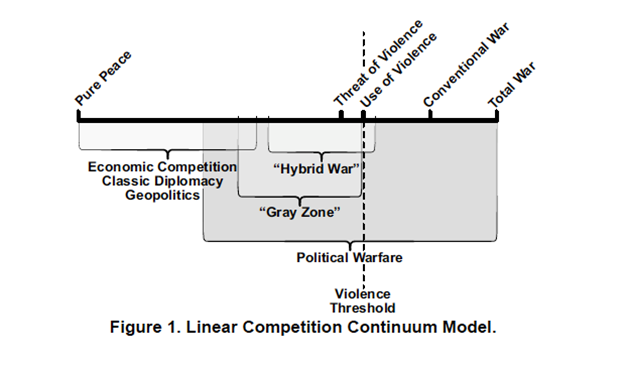Editor’s Note: Informational Professionals Association (IPA) Advisor Michael Williams offers his analysis of Marine Corps Doctrinal Publication 1-4: Competing. In this new publication, Marine Corps Commandant General David H. Berger focuses on the “competition continuum” as a guide for approaching varying levels of interactions that encompass today’s competitive landscape.
Chapters include:
Chapter 1. The Nature of Competition
Chapter 2. The Theory of Competition’
Chapter 3. Preparing for Competition
Chapter 4. How Rivals Approach Competition
Chapter 5. The Conduct of Competition
Read the post by Michael Williams:
I have an older set of the Marine Corps foundational doctrinal publications which occupy coveted space on my bookshelf because they are unusual. As a retired Army officer, I’m used to less than stellar thinking in Army doctrinal publications (looking at you FM 3-13) so when a colleague presented me with a set of these publications I was astounded with their brevity and clarity. I may not have agreed with everything written but I understood it all.
The good news with the latest Marine publication – MDCP 1-4 Competition is that it exists at all. Our “competitors and potential adversaries” understand very well that what is described in MCDP 1-4 is a range of activities inseparable from war. What we describe as “competition” can, in current Russian thinking be considered the shaping operation necessary to achieve success in what we call “conflict.”
The first few chapters address what the joint DoD community and other USG entities describe as the components of competition and here is where this publication gets off track and where our military continues to remain behind our adversaries.

The figure is good in that it describes a range of activities including “conventional war” and “total war” (though the distinction may be lost to those on the receiving end of a precision strike weapon). The figure is wrong however in drawing a dotted line between “gray zone” and the use of violence. This dotted line suggests that we cease using the tools that we think of as limited to gray zone or hybrid war activities when we cross into the use of violence. This continues to confuse our senior leaders as well as too many continue to think of the information environment as a battlefield in competition instead of thinking of the IE as an extension of the area of operations – in any conflict.
The speed of information movement, the volume of information availability (of vastly varying quality) and the ubiquity of handheld computing and communications means that Commanders must consider the role of information and how it can affect military outcomes. This means that operational level (and often tactical) planners must understand how the IE was shaped in competition and how this will continue to shape outcomes in conflict.
We can continue to mythologize “war” as the domain of force-on-force applications of violence or we can understand the shaping operations directed against us right now and understand how competition as practiced by our prospective adversaries will enable their operations in conflict.
MCDP 1-4 gets better in Chapter 4 How Rivals Approach Competition. The lessons of the last 20 years have (re-)taught us the necessity of understanding the impact of language and culture on decision-making. Chapter 4 describes the different interpretations of “competition” among our competitors and how at least one culture see it as just another form of war or a “permanent struggle mindset.” This is exactly what we need to understand about what we call “competition:” It is the necessary precursor to conflict. Not all competition will include conflict but we may need to better encompass this understanding of competition and its activities and how it extends into conflict and the impact those activities have on the achievement of military objectives.
Like almost all the MCDPs, MCDP 1-4 is certainly worth reading and absorbing but the reader won’t find anything new here. Hopefully a future edition will better integrate the role of military information activities in competition and conflict. In an attempt at dissecting competition, the pub is too long by half.
Some phrases in this publication worth keeping in any edition include:
“Sometimes the side that is able to combine adequate material with innovate ideas becomes the winner.”
“Our competitors across the globe recognize Western societies’ tendency to think of themselves as in either a condition of “at peace” or “at war.” (Note: Even though we often confuse ourselves about our own condition. See: American involvement in Afghanistan 2002-2020)
Marine Corps Doctrinal Publication 1 – Warfighting will get the last word:
“At the highest level, war involves the use of all the elements of
power that one political group can bring to bear against another.
These include, for example, economic, diplomatic, military, and
psychological forces. Our primary concern is with the use of military
force. Nevertheless, while we focus on the use of military
force, we must not consider it in isolation from the other elements
of national power.”
All the tools of competition are listed right there and while yes, the use of military force is the primary concern of the Marine Corps, we can no longer separate the “psychological” force and the role of information from the use of military force in conflict or competition.
edited for clarity on 8 January 2021
